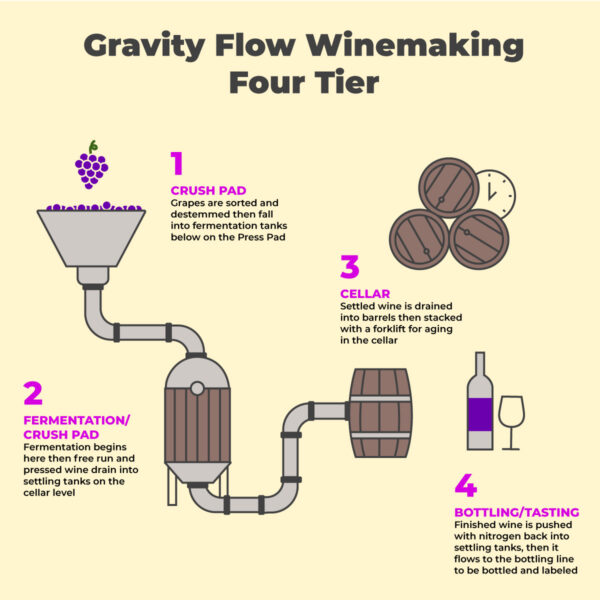Gravity-flow winemaking is a practice that is becoming well recognized by winemakers and vino fanatics. The process of gravity-flow winemaking (also known as “gravity-fed”), allows for the wine to stream through levels in the winery. Unlike traditional single-level cellars, there is no use of pumps or mechanical force, enabling the winemaker to gently extract colour, flavour and tannin.
Although gravity flow seems to be a new technique in the wine world, the process has actually been around since the 1800s and is a highlight of Australian winemaking history. In 1888, Seppeltsfield Estate in the famous Barossa Valley used gravity flow for almost 100 years. By 2010, the winery was remodelled with a million-dollar investment to include top of the line industry equipment.
What Happens in a Gravity-flow Winery?
The typical gravity-flow winery consists of four levels that follow regular winemaking steps. However, each stage is separated into different floor levels, allowing gravity to move the wine from crushing to cellaring.
The Four Steps of Gravity Flow Winemaking
A gravity-flow winery consists of mainly four steps to take the grapes from fruit to wine. Read on to learn more about each step and what it involves.
Step 1: Crush Pack
Clusters of grapes are brought by a forklift to the top floor of the winery where they are destemmed and crushed. The juice from the grapes slides to the fermentation barrels on a lower level through hoses that connect each level.
Step 2: Fermentation/Crush Pad
Regular fermentation takes place where natural or added yeasts turn grape juice into alcohol. Wineries are usually equipped with temperature control measures such as double-jacketed fermentation tanks. The wine is then pressed and it flows to the lower level.
Step 3: Cellar
The wine is drained from the fermentation tanks into barrels in the cellar. The wine sits in the barrels aging until it is ready to be bottled.
Step 4: Bottling
Bottling the wine typically uses nitrogen to push finished wine into bottles. However, the finishing touches vary according to the winery’s filtering, fining and settling choices.

What Are the Benefits of Gravity-Flow Winemaking?
Preserve Those Flavours
A gravity-flow winemaking process enhances the textures of wine. There is no excessive moving, pushing or external forces that are exerted on the wine. The system is gentle and allows the natural flavours and aromas of wine to develop.
In this video, Palmaz Vineyards shows off their innovative gravity-fed winery and how it was constructed.
Stratus Vineyards in Ontario is one of the few wineries that have embraced the gravity-flow winemaking process. They employ the use of a four-storey tank elevator that helps them move the wine around without any pumps involved that can introduce air into the wine and compromise its flavours. Instead, the wine flows due to gravity from stainless steel or oak fermenters into selected barrels to age. This allows the grapes to shine within the wine.
Efficient and Sustainable Winemaking
Wineries that don’t employ the gravity-flow system typically use pumps and machinery to move the wine around during the winemaking process. With no machinery or pumps needed, a gravity-flow system greatly reduces a winery’s costs and energy consumption.
What Are the Downfalls of a Gravity-Fed Winery?
You’ll Need Some Capital Upfront
There can be some downfalls to using a gravity-fed system for a winery. They can typically be costly to start up due to the costs of setting up the equipment at first. If a winery is thinking of transitioning to a gravity-flow system they may have to plan for incurred costs.
Architecture Matters
The way a winery is built can play an important role in whether a gravity-flow system can be employed or not. Usually, the building must be multiple stories to allow for the wine to flow easily during the winemaking process. Some buildings may not have the space to use this system.
It’s All About a Winery’s Individual Needs
The way a winery chooses to make their wine is usually specific to their individual needs and budgets. There have been many wineries in France and even Napa Valley that have chosen to use this method. Palmaz Vineyards, in Napa Valley, for instance, have been able to contribute to reducing water consumption when making wine. Some wineries choose to take advantage of their environment and terroir. Stoller Family Estate in Oregon has chosen to utilize the natural hillside when building their gravity-flow winery. Gravity-flow systems can definitely be ideal in some instances, and with some forethought and planning can become cheaper and more efficient in the long run.
Learn More with WineCollective
Subscribe to become a WineCollective member today to keep learning and exploring the world of wine, one winemaking method at a time!
